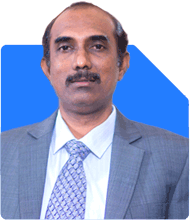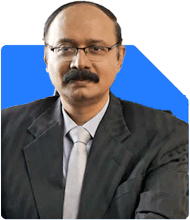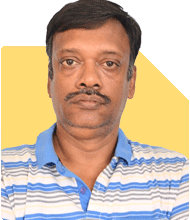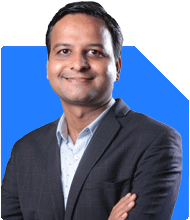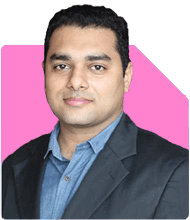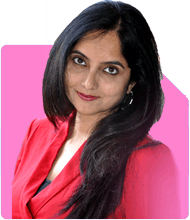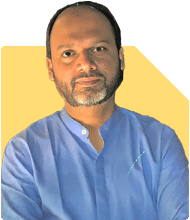Ramalingam Kalirajan |10870 Answers |Ask -Follow
Mutual Funds, Financial Planning Expert - Answered on Jul 09, 2025
He has an MBA in finance from the University of Madras and is a certified financial planner.
He is the director and chief financial planner at Holistic Investment, a Chennai-based firm that offers financial planning and wealth management advice.... more

Hi sir, Myself Rajesh Vishwakarma Age 39 Take home salary 2.8 lacs 60k expenditure Emi 85k pending home loan of 65 lacs. Mutual fund 40k/ monthly Term insurance 19k/annum Health insurance 25k/annum NPS 50k/annum. Ppf balance 22lacs. How to retire at the age of 50 with corpus of 5cr.
You are 39 years old now.
Retirement goal is set at age 50.
That gives you 11 years to build a Rs. 5 crore corpus.
Take-home monthly income is Rs. 2.8 lakhs.
Your monthly EMI is Rs. 85,000.
Monthly household expenses are Rs. 60,000.
You invest Rs. 40,000 monthly in mutual funds.
NPS contribution is Rs. 50,000 per year.
PPF balance is already Rs. 22 lakhs.
Term insurance and health insurance are in place.
Your income, expenses, and savings show strong discipline. This is a great starting point.
Evaluating Your Retirement Goal
You wish to accumulate Rs. 5 crores in 11 years.
You already have a solid base in PPF and mutual funds.
Your savings capacity can be increased further.
We need to optimise savings and investments together.
Corpus size depends on contribution, returns, and time.
Time is fixed. So focus on return and monthly contribution.
Loan Management Strategy
Outstanding loan of Rs. 65 lakhs is significant.
EMI of Rs. 85,000 takes a big share of your income.
Home loan should be closed before retirement.
Check loan tenure. Try to reduce the duration.
Consider prepayments when you get bonuses or surplus.
Don’t compromise mutual fund SIPs for prepayments.
Strike a balance between investment and debt repayment.
Avoid adding new loans until this is repaid.
Investment Efficiency and Asset Allocation
Monthly SIP of Rs. 40,000 is good. Can be improved.
You have a high risk appetite given your profile.
A mix of large-cap, flexi-cap and mid-cap funds helps.
Avoid small-cap overweight for now. Maintain diversification.
Don’t invest in direct funds without support.
Regular funds offer support from MFDs with CFP credential.
Direct plans lack personalised rebalancing and review.
Regular plans are better for consistent hand-holding.
Why Not Index Funds
Index funds follow the market passively.
They can underperform in volatile markets.
Actively managed funds try to outperform the index.
They are better during market corrections or side-ways trends.
Fund managers adjust portfolio based on market trends.
Index funds do not offer that advantage.
Stay invested in active mutual funds for now.
PPF Strategy Assessment
You already have Rs. 22 lakhs in PPF.
This is a great low-risk, tax-free component.
Continue annual contributions if possible.
Maximise yearly limit of Rs. 1.5 lakhs.
This gives assured returns with tax benefits.
Do not withdraw from PPF unless absolutely needed.
It can provide cushion in early retirement years.
Review of NPS Allocation
Annual contribution of Rs. 50,000 is decent.
NPS offers additional tax benefits under Sec 80CCD(1B).
Equity allocation in NPS should be reviewed yearly.
Try to keep 75% equity allocation if your risk permits.
Auto choice may reduce equity allocation with age.
Manual allocation gives more control.
Withdrawals are taxed partially. Plan accordingly.
Emergency Fund and Risk Cover
No mention of emergency fund in your note.
Keep Rs. 5–6 lakhs in liquid fund or savings.
It should cover 4–6 months of expenses and EMI.
Term cover of Rs. 19,000/year is good.
Ensure coverage is 15–20 times your annual income.
For Rs. 2.8 lakh monthly income, cover should be Rs. 1 crore+.
Health insurance is in place. Check if it covers family.
Also include top-up plans if budget allows.
Scope to Increase Investments
Your total monthly outflow is Rs. 1.85 lakhs.
You are left with approx. Rs. 95,000 per month.
From this, increase mutual fund SIPs by Rs. 20,000.
Use balance for emergency fund and prepayments.
Gradually raise SIPs every year as income rises.
Aim for Rs. 70,000 per month in SIPs over 3–4 years.
This helps you close the gap toward Rs. 5 crore.
Asset Allocation Guidance
Keep 70% in equity mutual funds.
20% in PPF, NPS and debt mutual funds.
10% in liquid fund or short-term fixed deposits.
Review allocation every year.
Shift some equity to hybrid or debt 2 years before retirement.
Withdrawal Strategy Post Retirement
Your monthly expense now is Rs. 60,000.
At age 50, it may rise to Rs. 1 lakh due to inflation.
Retirement corpus should provide Rs. 1 lakh/month.
Create 3 buckets post-retirement:
Bucket 1: Liquid funds for 3 years' expenses.
Bucket 2: Short-term debt for next 5 years.
Bucket 3: Balanced equity for long term.
Start Systematic Withdrawal Plan (SWP) after retirement.
Withdraw only what you need. Let rest stay invested.
Avoid full redemption at once.
How Mutual Fund Tax Rules Apply
Equity mutual funds have new tax rules.
LTCG above Rs. 1.25 lakh taxed at 12.5%.
STCG is taxed at 20%.
Debt mutual fund gains taxed as per your slab.
Use SWP to reduce tax impact after retirement.
Split redemption across years to stay below Rs. 1.25 lakh gain.
Always keep transaction records updated for tax filing.
Additional Suggestions for Retirement Goal
Review financial plan once every 6 months.
Increase SIPs annually as income grows.
Don’t mix insurance and investment.
If you hold ULIPs or LIC endowment plans, review return.
Surrender if return is below 6%. Reinvest in mutual funds.
Don’t chase exotic investment options.
Stay with time-tested and diversified funds.
Avoid real estate. It blocks capital and creates liquidity issues.
Instead, stay with financial assets for better control.
Finally
Your goal of Rs. 5 crore is realistic.
You have 11 years and a good base to start.
Increase mutual fund SIPs gradually to Rs. 70,000.
Prepay home loan but without sacrificing investments.
Secure emergency fund and increase insurance cover.
Align all assets with your retirement timeline.
Don’t ignore tax planning and withdrawal strategy.
Take help of MFDs with CFP certification.
They give personalised and goal-based advice.
Avoid DIY with direct funds for retirement planning.
Stay invested, stay disciplined, and review regularly.
Best Regards,
K. Ramalingam, MBA, CFP,
Chief Financial Planner,
www.holisticinvestment.in
https://www.youtube.com/@HolisticInvestment
You may like to see similar questions and answers below
Ramalingam Kalirajan |10870 Answers |Ask -Follow
Mutual Funds, Financial Planning Expert - Answered on Apr 30, 2024
Ramalingam Kalirajan |10870 Answers |Ask -Follow
Mutual Funds, Financial Planning Expert - Answered on Jul 10, 2024
Ramalingam Kalirajan |10870 Answers |Ask -Follow
Mutual Funds, Financial Planning Expert - Answered on Aug 29, 2024
Ramalingam Kalirajan |10870 Answers |Ask -Follow
Mutual Funds, Financial Planning Expert - Answered on Jul 29, 2025
Dr Dipankar Dutta |1836 Answers |Ask -Follow
Tech Careers and Skill Development Expert - Answered on Dec 05, 2025
Ulhas Joshi |280 Answers |Ask -Follow
Mutual Fund Expert - Answered on Dec 05, 2025
Dr Dipankar Dutta |1836 Answers |Ask -Follow
Tech Careers and Skill Development Expert - Answered on Dec 04, 2025
Ravi Mittal |676 Answers |Ask -Follow
Dating, Relationships Expert - Answered on Dec 04, 2025
Anu Krishna |1745 Answers |Ask -Follow
Relationships Expert, Mind Coach - Answered on Dec 04, 2025
Anu Krishna |1745 Answers |Ask -Follow
Relationships Expert, Mind Coach - Answered on Dec 04, 2025
Mayank Chandel |2562 Answers |Ask -Follow
IIT-JEE, NEET-UG, SAT, CLAT, CA, CS Exam Expert - Answered on Dec 04, 2025
Mayank Chandel |2562 Answers |Ask -Follow
IIT-JEE, NEET-UG, SAT, CLAT, CA, CS Exam Expert - Answered on Dec 04, 2025
Mayank Chandel |2562 Answers |Ask -Follow
IIT-JEE, NEET-UG, SAT, CLAT, CA, CS Exam Expert - Answered on Dec 04, 2025
Mayank Chandel |2562 Answers |Ask -Follow
IIT-JEE, NEET-UG, SAT, CLAT, CA, CS Exam Expert - Answered on Dec 04, 2025





